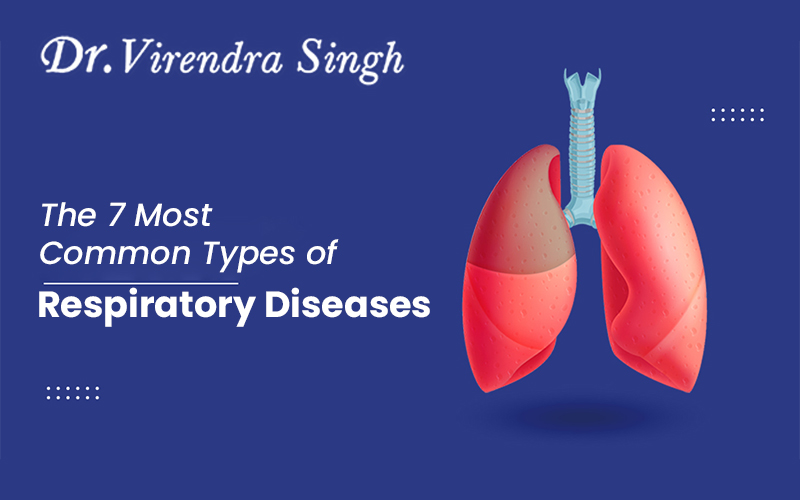
Top 7 Most Common Types of Respiratory Illnesses & Diseases: Respiratory diseases are affecting millions of people around the globe, causing suffering, pain, and even death in severe cases. These conditions are like thieves stealing the airways and lungs from individuals, making breathing difficult.
Long-term chronic conditions all cause a dramatic decrease in quality of life. This blog will cover the seven main types of respiratory disease, including their symptoms and treatment modalities. This information can be very useful, especially when we know how to prevent such conditions and when to seek medical attention as needed.
1. Asthma
Asthma is a permanent inflammation that affects the airways, leading to them narrowing and at times, swelling. This leads to symptoms such as:
- Wheezing
- Shortness of breath
- Chest tightness
- Coughing
Different factors, such as allergens, physical exercise, voices of stress, and cold respiratory infections can trigger allergy attacks. Treatment is most often accomplished by applying inhaled corticosteroids and bronchodilators to restrain inflammation and expand the airways. Aside from that, triggers and their avoidance are also used in this asthma management.
2. COPD
COPD is a progressive lung condition that usually includes emphysema and chronic bronchitis. It is a disease-specific to chronic airflow limitation. As a result, the air shift impedes breathing, making breathing very difficult. Symptoms most likely are chronic cough, excessive mucus production, whistling, and breathlessness.
The main mechanisms in the development of COPD are largely due to chronic exposure to particles of air pollution, tobacco smoke, and dust. We heal the symptoms, treat the disease, and help through combining medications, oxygen therapy, and lifestyle changes like smoking cessation and earning a pulmonary rehab.
3. Cystic fibrosis
Cystic fibrosis (CF) is an inherited structural damage of the genotype, affecting the lungs and digestive system. A defective gene in CF patients causes thicker and more dense mucus, devastation of the lobes and pancreas functions.
Symptoms:
- Persistent coughing
- Wheezing
- Frequent lung infections
- Poor growth and weight gain
Currently, a cure for CF is not an option. However, symptoms and complications can be prevented, and the treatment plan aims to alleviate symptoms. These include noninvasive procedures such as chest physical therapy, inhaled medication, and digestive enzyme supplements, provided in the diet plan and a high-calorie diet.
4. Lung Cancer
Lung cancer is one type of cancer that starts in the tissues of the lungs and can then spread to other organs in the body. Worldwide cancer death deaths are the highest and ranked first. The sniffles, accompanied by a cough, could last longer than usual, chest pain and shortness of breath, and unusual voice, including body weight loss, are some of those symptoms.
The overwhelming lung cancer’s cause is smoking, and, in turn, passive smokers are also in danger of other carcinogens such as asbestos, radon, and just air pollution. The type of lung cancer and the stage of the cancer may affect the treatment.
5. Tuberculosis
Lung tuberculosis is an infectious bacterial disease most commonly spread today. It is transferred in a variety of ways – those include:
- Coughing,
- Sneezing,
- Speaking,
- Forth.
The key mechanism in this process is breathing. Coughing is a persistent cough more than three times a week, sometimes accompanied by chest pain, fever, night sweating, and weight loss without intention.
Sputum diagnosis and antitubercular treatment involve a combination of two or a few antibiotics for a few months. Thus, it is essential to have a full treatment course uninterrupted to avoid generating strains of multidrug-resistant pathogens, which may compromise the success of the overall treatment outcome.
6. Bronchitis
Bronchitis is bronchial inflammation, as seen through the bronchi, the largest airways in the lungs where the air is transported. It can be either an acute disorder (short-term) or a chronic peril (long-term). Symptoms can manifest as coughing, mucus production, chest discomfort, feeling that one is choking, and frustration with the inability to deep breath.
Acute bronchitis is mostly viral in origin, and it resolves by itself, as in the case of most patients, in two weeks. Chronic bronchitis is different from what is known as chronic obstructive pulmonary disease, which is the main cause of COPD due to prolonged inhalation of irritants such as heavy tobacco smoke.
Rest, hydration, and OTC pain relievers will be recommended, along with treatment based on the severity of the symptoms during the initial visit. Sometimes, doctors prescribe antibiotics and asthma inhalers to people with only mild symptoms.
7. Pneumonia
Pneumonia is a disease of air sacs in the air lung or just one small lung. This results in fluids or pus filling all the air sacs. Cold symptoms can be mild to moderate and may range from nonpathogenic ones like congestion and chest tightness to high-grade illnesses like fever and extreme breathing difficulty. Pneumonia is the most common respiratory disorder characterized by various infection agents, such as bacteria, viruses, and fungi.
Treatment can be developed according to the disease intensity and may include a type of antibiotic, rest, hydration, and common non-steroidal anti-inflammatory drugs that relieve pain. As the disease can make the breathing process difficult in severe cases, the patient may be faced with admission into a hospital and the use of a respirator or oxygen support.
Conclusion
Respiratory diseases can be serious health problems that affect people’s well-being. If you have been experiencing prolonged or disturbing respiratory symptoms, a good way to get help is to contact a qualified healthcare professional like Dr. Virendra Singh. Proper diagnosis and treatment of respiratory diseases enable remedial measures that enable most patients to live comfortable and full lives.
